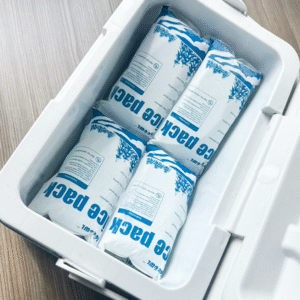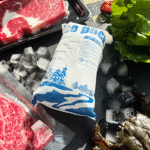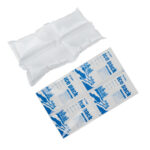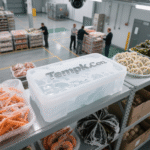Trockeneis zum Packen von Essen: 2025 Vollständige Sicherheit & Größenanleitung
If you plan to verwenden dry ice to pack food, follow the 5–10 lb per 24 H Regel, add a one-day buffer, das Paket entlüften, and label it correctly. This ensures your shipment stays frozen, sicher, and compliant with 2025 carrier regulations. Dry ice works better than ice packs by keeping items ultra-cold without leaks or moisture damage
-
How much dry ice to pack food for 24–120 hours
-
Which packaging and insulation work best for frozen shipping
-
Rules for labeling and carrier compliance in 2025
-
Safety tips for handling and venting dry ice
-
When to choose pellets vs. blocks for better results

How Much Dry Ice to Pack Food for Shipping?
Schnelle Regel: Planen 5–10 Pfund Trockeneis pro 24 Stunden Transit, Fügen Sie dann einen zusätzlichen Tag als Puffer hinzu. Use the higher range for hot weather, dünne Isolierung, or small pellets that sublimate faster. Always write the net weight in kilograms on the outside label.
Warum funktioniert das: Dry ice sublimates at –79 °C (–110 °F), absorbing large amounts of heat as it turns to CO₂ gas. This makes it efficient for maintaining frozen temperatures in insulated containers.
Example Sizing Table
| Transitzeit | Trockeneis benötigt | What It Means for You |
|---|---|---|
| 12–24 h | 5–10 lb | Thick insulation → 5 lb; hot lanes → 10 lb |
| 48 H | 10–20 lb | Prefer blocks or ≥10 mm pellets |
| 72–96 h | 20–40 Pfund | Test runs recommended; limit door openings |
| 120 H | 40–60 Pfund | VIP shippers reduce required weight by ~25% |
Which Packaging Works Best to Use Dry Ice to Pack Food?
Kernaufbau: Always use an insulated container (EPS -Schaum, Pur, or VIP for long routes), mit Trockeneis placed above the food since cold air sinks. Packages must be vented to release CO₂ gas.
Pellets vs. Blöcke
-
Blöcke (längerer Halt): Last 48–96 hours, langsamere Sublimation.
-
Pellets (faster chill): Great for quick cooling but sublimate faster.
-
Hybrid: Blocks at the base + pellets on top balance speed and longevity.
Container Choices
| Containertyp | Am besten für | Warum es dir hilft |
|---|---|---|
| EPS Foam Shipper | 24–48 h | Budgetfreundlich, easy to source |
| VIP Shipper | 72–120 Std | Uses less dry ice; höhere Vorabkosten |
| Hartes Kühler | Vielseitig einsetzbar | Dauerhaft, wiederverwendbar, good for rough handling |
Was sind die 2025 Rules for Shipping with Dry Ice?
Lufttransporte (Iata 2025): Markieren „Trockeneis/Kohlendioxid, solid – UN1845”, enthalten Nettogewicht in kg, shipper/consignee details, und eine Klasse anwenden 9 Etikett. Nutzen Sie die IATA 2025 Acceptance Checklist when a Shipper’s Declaration isn’t required.
USPS: Maximum 5 lb per air mailpiece, Nur inländisch, kein internationales.
UPS & FedEx: Follow PI954 rules. FedEx Ground does not treat dry ice as hazardous, but you must still mark the package. UPS may require an ISC contract for international air shipments.
Safety Tips When You Use Dry Ice to Pack Food
-
Belüftung: Never seal containers airtight; dry ice releases CO₂ gas.
-
Handhabung: Tragen Sie immer isolierte Handschuhe; Vermeiden Sie direkten Hautkontakt.
-
Expositionsgrenzen: OSHA sets 5,000 ppm TWA and 30,000 ppm STEL for CO₂ in workplaces.
-
Recipient notice: Inform the recipient the package contains dry ice.
Real Case: A bakery reduced “soft-on-arrival” claims by 35% after switching from pellets to block-dominant dry ice for 2-day routes. Same weight, längerer Halt.
2025 Markt- und Technologietrends
-
Updated Regulations: IATA 66th DGR Addendum effective April 2025; USPS continues 5 LB Air Cap.
-
VIP Shippers Mainstream: More frozen lanes use vacuum-insulated panels to cut dry ice needs.
-
Intelligente Überwachung: QR-enabled TTIs and Bluetooth loggers provide full cold-chain visibility.
-
Nachhaltiges Trockeneis: Suppliers are increasingly using reclaimed CO₂, Verringerung der Umweltbelastung.
Häufig gestellte Fragen
Q1: How much dry ice to pack food for 48 Std.?
Use 10–20 lb depending on insulation and weather; always add one day extra.
Q2: Kann Lebensmittel direkt mit Trockeneis in Berührung bringen?
NEIN. Always wrap food and separate it with liners or spacers to prevent freezer burn.
Q3: Is dry ice allowed by FedEx Ground?
Ja, but the package must be labeled “Dry Ice – UN1845.”
Q4: Can I fly with dry ice to pack food in my luggage?
Ja, bis zu 2.5 kg (5.5 lb) pro Passagier, Mit Fluggesellschaftszulassung und belüfteter Verpackung.
Zusammenfassung & Empfehlungen
-
Plan 5–10 lb/24 h + 1 day buffer
-
Use insulated shippers (EPS, VIP) with vents
-
Etikett mit UN1845 + Netz kg
-
Choose blocks for long routes, Pellets für Geschwindigkeit
-
Always handle and dispose of dry ice safely
Nächster Schritt: Test your packout with a small shipment and adjust by ±20%. For compliance and efficiency, prepare pre-printed UN1845 labels and validate your packaging with data loggers.
Über Tempk
Und Tempk, Wir spezialisieren uns auf Kaltkettenverpackung for food and biotech. We design validated shippers, right-size dry ice usage, and provide SOPs and label templates that keep your shipments compliant and safe. Our clients reduce spoilage claims while cutting coolant costs with tailored block/pellet mixes and lane-specific planning.
Aufruf zum Handeln: Kontakt tempk today for a free 15-minute consultation and route-specific dry ice calculator.























